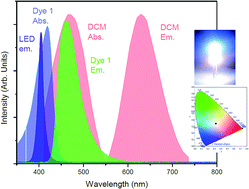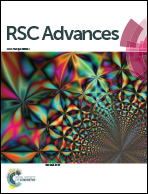A facile strategy for new organic white LED hybrid devices: design, features and engineering†
Abstract
A facile and ecofriendly strategy to design and engineer new organic white LEDs is tested. The hybrid system was implemented by combining a commercial blue LED, with emission at 405 nm, with a hybrid transparent organic film (polycarbonate, PMMA, PVC) containing two selected organic dyes. The emitting molecules, a home-designed push–pull based coumarin and DCM ([2-[2-[4-(dimethylamino)phenyl]ethenyl]-6-methyl-4H-pyran-4-ylidene]-propanedinitrile), were selected for their optical features and appropriately mixed to obtain white light, perceptible by the naked eye, through the metamerism effect. The proposed strategy shows the critical parameters to account for in the selection of organic dyes, bearing in mind the preservation of the dye emission properties from the solution to the solid state. To this purpose, the contributions of dynamic and static quenching effects were analyzed in detail, to single out the optimum concentrations to assure the compliance with the respective sphere of interaction and guarantee high optical performances. Different new hybrid white-emitting LEDs, with tunable color rendering index (from warm to cold CCT), high energy efficiency (quantum yield larger than 90%), and high photostability, were produced to prove the proposed strategy.


 Please wait while we load your content...
Please wait while we load your content...